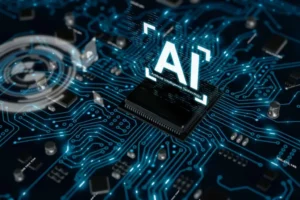Human-in-the-Loop: Enhancing AI and ML Efficiency

Every time a new AI tool enters the workplace, the conversation quickly turns to whether machines will replace people. A better way to look at it is how humans and AI can work together. As Karim Lakhani, a Harvard Business School professor known for his work on AI and innovation, puts it, the real disruption isn’t machines taking over. It’s people with AI tools overtaking people without them. It reveals that no matter how advanced, AI still requires human oversight. In business settings, it means finance teams check algorithm-driven forecasts, or customer support managers adjust chatbots to respond more naturally. Human-in-the-loop is the framework behind this collaboration. It ensures AI doesn’t just run on numbers but reflects human judgment, responsibility, and context.
What is Human-in-the-Loop (HITL)?
Let’s start with HITL meaning. “Human-in-the-loop” (HITL) is an approach where AI works not by itself, but together with a person. The machine does not simply issue a solution, but involves a person in the process.
Why is this needed? AI is good at calculation; it quickly processes data and identifies patterns. But it lacks what we have: an understanding of the context, an ethical perspective, and the ability to adapt to the situation. Therefore, HITL combines the strengths of both sides: the machine makes complex calculations, and the person adds flexibility and common sense.
Such an approach did not appear straight away. Previously, AI systems were simple and worked only in controlled conditions. When they began to be used in critical areas, such as healthcare, finance, or content moderation, it turned out that complete automation might produce unexpected or even harmful results.
The turning point came when it became evident: the best AI is not the one that replaces a person, but the one that helps them. This is how the HITL approach was formed.
But it is worth distinguishing between the two levels. In classic HITL, a human participates in every decision together with the machine. In the “human-on-the-loop” version, the system works more independently, and the human simply observes and intervenes only when it is really necessary. This difference is crucial because it determines how we will deploy AI and who will be accountable for its work.

We are confident that we have what it takes to help you get your platform from the idea throughout design and development phases, all the way to successful deployment in a production environment!
Why is Human-in-the-Loop (HITL) Important?
You can understand how HITL works, but the real question lies in understanding why it’s worth using in the first place. Simple answer: automation by itself falls short. Businesses need someone watching to keep AI systems accurate, fair, and trustworthy. Let’s take a look at a few reasons you should be thinking about this approach:
- HITL lets you track if your AI tool actually works. Major banks use AI to flag suspicious transactions, but human analysts review each case. Initially catching problems 60% of the time, human feedback improved accuracy to over 85%. Analysts teach systems to recognize new fraud patterns which were not present in the original training data.
- Artificial intelligence works well as long as everything goes according to plan. But when the situation becomes complicated or unusual, it is lost without a person. As an illustration, in hospitals, AI helps radiologists look for signs of cancer. But doctors often take on cases where the tumor is masked and difficult to detect. The case is similar to lawyers: AI quickly checks standard contracts, but with delicate issues, such as intellectual property, a lawyer copes better.
- AI easily picks up errors from the data on which it was trained. As an illustration, one large company abandoned a system for selecting personnel when it was revealed it had underestimated the resumes of women. And some credit card services discovered their algorithms give different limits to men and women, even if financial indicators are the same.
In many areas, a person still has to intervene. Specialists regularly update tax programs to comply with new rules. Taxi and car-sharing drivers report what’s actually happening on the roads during significant events, which helps algorithms build fairer prices. And technical support works more confidently when senior specialists review complex cases before AI responds.

Benefits of Human-in-the-Loop (HITL)
When people and AI team up, you get more than just better tech: you get something businesses can actually use. Human-in-the-loop delivers real benefits:
- Better accuracy. Banking fraud detection works like this: AI spots suspicious activity, humans figure out if it’s actual fraud or just someone’s unpredictable spending habits. A human double-check makes the system more precise and keeps customers happy.
- Cleaner data. In fields like healthcare and niche finance, there usually aren’t massive datasets. Experts label and prepare the data so the AI gets quality input instead of stale information.
- Less bias. Algorithms tend to pick up the same prejudices found in their training data. In hiring, for example, HR teams come in when an AI starts unfairly filtering out strong candidates and correcting it before it causes real problems.
- Real efficiency gains. AI scans invoices, contracts, and transaction records, then hands you a shortlist of the important things. You skip hours of tedious work but still make the final decisions.
HITL lets businesses use AI in ways that work: practical, legal, and realistic. It makes systems smarter, useful, fair, and ready for daily business reality.
Real Examples of Human-in-the-Loop (HITL)
HITL theory sounds nice, but here’s how it actually works day-to-day. Banks run AI that scans thousands of transactions per second, flagging suspicious activity. Human analysts get those alerts and decide what’s actually risky. They teach the model to stop creating a false alarm in specific cases.
Accounting departments do something similar. AI reads invoices and receipts, pulls out the data, but has problems with unusual formats or someone’s handwriting. Accountants clean up the mistakes and show the system what it missed. Over time, less manual cleanup needed.
Customer service runs on this, too. Chatbots handle the easy questions: password resets, account balances, shipping updates, or checking order status. Tricky problems get forwarded to real people. Every time support resolves something, the bot learns from it and handles similar issues better next time. 72% of consumers prefer live operators to virtual assistants for complicated issues. Businesses using HITL report an average handling time reduction of 20–40%.
Recruitment screening works the same way. AI goes through resumes, but recruiters make sure good candidates don’t get dismissed because the algorithm got picky about the wrong things. They catch when the system misses qualified people and fix the filters.
Healthcare uses it heavily. Diagnostic AI spots potential problems in scans, highlights what looks abnormal. Doctors provide the medical context and make the actual treatment decisions. The AI points, humans decide.
Each field follows the same pattern: AI does the work, humans make the decisions, and both get better at their jobs.
Implementing a Human-in-the-Loop System
Building a “human-in-a-loop” system always starts with a goal. You need to clearly decide: what is more important right now — accuracy, speed, or stability of results. The decision determines the next steps.
Next comes work with data. If there are no ready-made sets, the team creates them themselves. Then the data is cleaned, organized, and brought into a single format so that the system may use it.
After that, the first version of the model is launched. It’s far from ideal, but it provides a basis for further improvement. At this stage, people play an important role: they check the results, correct errors, and return the refined data to the system. Each such circle makes the model more accurate.
The most interesting thing is active learning. First, attention is paid to the most difficult cases because they are the ones that make the most progress. And so the cycle repeats itself over and over again: result, check, fix, new learning. Over time, the model requires less intervention, but people do not disappear completely. Data changes, new information appears, and it is vital to notice problems in a timely manner. The cycle continues to operate, ensuring the system remains stable and useful.
Essential Considerations When Using the HITL Approach
Human-in-the-loop sounds excellent on paper, but anyone who’s tried it in practice knows it comes with challenges — the two big ones: scaling and cost. Let’s start with scaling. Every model update requires input from annotators, reviewers, or the person responsible for verifying the system. The more challenging the task, the more people you need to complete it. To get around that, companies lean on smarter algorithms that need fewer corrections or use reinforcement learning from AI feedback (RLAIF) so machines handle more of the work on their own.
Then there’s the money side. Every extra person in the loop means additional expenses. Consider wages for annotators or the hours spent on quality checks. If you’re a small company or working on a lean budget, that bill adds up fast. A lot of teams push hard to cut down repetitive human tasks. The less often you need someone to step in, the easier it is to keep costs under control.
HITL has its perks, but it comes with significant trade-offs. To keep it practical, businesses have to find the sweet spot between human oversight and smart automation.
As AI becomes smarter, it still requires a human touch to keep it on track. People must check accuracy, spot mistakes, and deal with bias. When humans and machines collaborate, you get the best of both worlds. AI can work with numbers, process data, and adapt fast, while humans bring context, judgment, and a sense of what’s actually reasonable. It makes AI valuable instead of a trend.
While this approach may slow down processes, it provides better results and accountability, which is especially important in areas with a high cost of error. The essence of the method is the correct division of roles: the machine works quickly with big data, and the human intervenes where judgment and strategic assessment are indispensable. It allows you to build an effective human-machine partnership and create a long-term competitive advantage.
Top Articles
Human-in-the-Loop: Enhancing AI and ML Efficiency
I am here to help you!
Explore the possibility to hire a dedicated R&D team that helps your company to scale product development.






